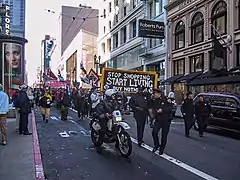Buy Nothing Day
Buy Nothing Day is an international day of protest against consumerism. In North America, the United Kingdom, Finland, and Sweden, Buy Nothing Day is held the day after U.S. Thanksgiving, concurrent to Black Friday; elsewhere, it is held the following day, which is the last Saturday in November.[1][2] Buy Nothing Day was founded in Vancouver by artist Ted Dave[3] and subsequently promoted by Adbusters[4] based in Canada.
| Buy Nothing Day | |
|---|---|
 Buy Nothing Day demonstration in San Francisco, November 2000 | |
| Type | Cultural |
| Significance | Protest against consumerism |
| Date | Day after U.S. Thanksgiving |
| 2020 date | November 27 |
| 2021 date | November 26 |
| 2022 date | November 25 |
| 2023 date | November 24 |
| Frequency | Annual |
| First time | September 1992 |
| Related to | Black Friday, Cyber Monday, Green Monday, Small Business Saturday, Thanksgiving |
| Part of series on |
| Anti-consumerism |
|---|
The first Buy Nothing Day was organized in Canada in September 1992 "as a day for society to examine the issue of overconsumption." In 1997, it was moved to the Friday after American Thanksgiving, also called "Black Friday", which is one of the ten busiest shopping days in the United States.[5] In 2000, some advertisements by Adbusters promoting Buy Nothing Day were denied advertising time by almost all major television networks except for CNN.[1] Soon, campaigns started appearing in the United States, the United Kingdom, Israel, Austria, Germany, New Zealand, Japan, the Netherlands, France, Norway, Finland, and Sweden.[6] Participation now includes more than 65 nations.
Activities
.jpg.webp)
Various gatherings and forms of protest have been used on Buy Nothing Day to draw attention to overconsumption:
- Credit card cut-up: Participants stand in a shopping mall, shopping center, or store with a pair of scissors and a poster that advertises help for people who want to put an end to mounting debt and extortionate interest rates with one simple cut. Namely, by destroying their credit card by cutting it with the scissors.
- Free, non-commercial street parties
- Sit-in
- Zombie walk: Participant "zombies" wander around shopping malls or other consumer havens with a blank stare. When asked what they are doing, participants describe Buy Nothing Day.
- Whirl-Mart : Participants silently steer their shopping carts around a shopping mall or store in a long conga line without putting anything in the carts or actually making any purchases.
- Public protests
- Wildcat General Strike: A strategy used for the 2009 Buy Nothing Day where participants not only do not buy anything for twenty-four hours but also keep their lights, televisions, computers and other non-essential appliances turned off, their cars parked, and their phones turned off or unplugged from sunrise to sunset.
- Buy Nothing Day hike: Rather than celebrating consumerism by shopping, participants celebrate the Earth and nature.
- Buy Nothing + Critical Mass: As the monthly Critical Mass bicycle ride often falls on this day or near, rides in some cities acknowledge and celebrate Buy Nothing Day.
- Buy Nothing Day paddle along the San Francisco waterfront: This event is promoted by the Bay Area Sea Kayakers to kayak along the notoriously consumptive San Francisco waterfront.
- Buy Nothing Coat Exchange: Coats are collected throughout the month of November from anyone who wants to donate and brought to various locations within each state. On the day after Thanksgiving, many opt out of shopping on Black Friday to donate or volunteer. Anyone who needs a winter coat is welcome to exchange one or just take one. Originating in Providence, Rhode Island, similar winter coat exchanges take place on Buy Nothing Day in Kentucky, Utah, and Oregon.
Buy Nothing Christmas
Buy Nothing Christmas started unofficially in 1968, when Ellie Clark and her family decided to publicly disregard the commercial aspects of the Christmas holiday.[7] Contemporarily, a movement was created to extend Adbusters' Buy Nothing Day into the entire Christmas season.[8] Buy Nothing Christmas first became official in 2001 when a small group of Canadian Mennonites created a website and gave the movement a name.[9] Adbusters in 2011 renamed the event Occupy Xmas,[10] a reference to the Occupy movement. Buy Nothing Day was first joined with Adbusters' Buy Nothing Christmas campaign, which
Shortly after, Lauren Bercovitch, the production manager at Adbusters Media Foundation, publicly embraced the principles of Occupy Xmas, advocating "something as simple as buying locally—going out and putting money into your local economy—or making your Christmas presents".[11] Previously, the central message of Occupy Xmas and Occupy Christmas differed in that Occupy Xmas called for a "Buy Nothing Christmas" and Occupy Christmas called for support of local economy, artists, and craftspeople in holiday shopping. The union of these ideologies calls for a Buy Nothing Day to kick off a season of supporting local economy and family.
See also
References
- "Buy Nothing Day"The Guardian.co.uk
- "Buy Nothing Day"Adbusters.org
- Crook, Barbara. "Can you say bye to buying 1 day a year?" Vancouver Sun. September 25, 1991
- Click Here to Buy Nothing. Joanna Glasner. Wired, November 22, 2000.
- Verdon, Joan. "The 10 Busiest Shopping Days At Stores: Why They Now Matter More To Stores Than Shoppers". Forbes. Retrieved April 7, 2020.
- Jonas Lindkvist (1998). "1998, köp-inget-dagen" (in Swedish). En köpfri dag. Retrieved August 16, 2015.
- "About Us". Buynothingchristmas.org. Retrieved January 3, 2017.
- Susan Alessandri (2012), Mary Kosut (ed.), Encyclopedia of Gender in Media, SAGE, p. 398, ISBN 9781506338286
- Priesnitz, Wendy. "A Buy Nothing Christmas." Natural Life Magazine, November/December 2006. Retrieved 27 November 2008.
- Occupy Xmas, Archived December 31, 2011, at the Wayback Machine
- "An occupied Christmas". The Fulcrum. December 7, 2011. Retrieved November 28, 2020.
External links
- The Buy Nothing Day - thematic page (2018) by Adbusters Media Foundation
- BND UK information and support for UK campaigners